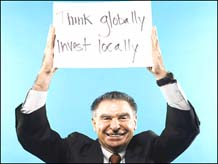5 smart bond movesThe best strategy for most investors is to stick with a bond index fund. Here are some good bets.(Fortune Magazine) -- A plain-vanilla asset that generates steady returns - that's how most investors view bonds, and lately they've been living up to that image. Since the beginning of the year, most investments up and down the credit-quality scale have returned between 3% and 6%, according to research firm Lipper, just enough to deliver the two things that make fixed-income investments part of a balanced portfolio: a reliable income stream and safety of principal. Bond-fund managers and economists predict more of the same in 2007. The spread between Treasuries and higher-yield (i.e., riskier) corporate and junk bonds is narrow, meaning that investors aren't really rewarded for taking additional risk. The markets seem to expect the Federal Reserve to cut rates, but Fed officials are saying they remain concerned about inflation - a hint that they may hold rates steady or at the very least will not cut them fast enough to satisfy Wall Street.
The best strategy for most investors is to stick with a bond index fund. Vanguard offers an unbeatable assortment, including the tried-and-true Vanguard Total Bond (Charts). Or pick a broadly diversified fund that has managers who can conquer challenging market conditions. Morningstar named Stephen Kane, Laird Landmann, Tad Rivelle, and David Lippman at Metropolitan West Total Return (Charts) its fixed-income managers of the year for 2005. Their nearly $2 billion fund has a 0.65% expense ratio and an average five-year return of 5.25%. Harbor Bond (Charts), managed by bond king Bill Gross, is another strong choice. The $2.3 billion fund has annual expenses of 0.58% and boasts a 5.59% average five-year return. For high-tax-bracket investors, tax-free municipal bonds are a smart choice. "Year to date, the total return has been right up there with their taxable peers', yet they will provide a much better return on an after-tax basis," says Lipper analyst Jeff Tjornehoj. For example, short-term muni debt has returned 2.9% since January 2006. If you're in the 35% tax bracket, the tax-equivalent return is 4.5%, and California muni debt funds have returned close to 5%, or 7.7% on an after-tax basis. One excellent tax-free fund option is Eaton Vance National Municipals (Charts), which has a 0.76% expense ratio and an 8.7% average five-year return. And if you, like the Fed, are worried about rising inflation, consider Treasury inflation-indexed securities. Known as TIPS, they pay a fixed interest rate, but their principal is adjusted to keep pace with the consumer price index. A solid and inexpensive choice is Vanguard Inflation-Protected Securities Fund (Charts), which has a 0.2% expense ratio and a 7.31% five-year return. |
Sponsors
| ||||||||||||||||||

